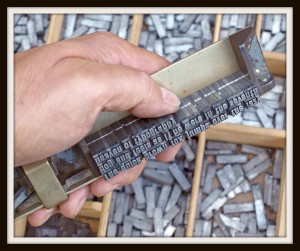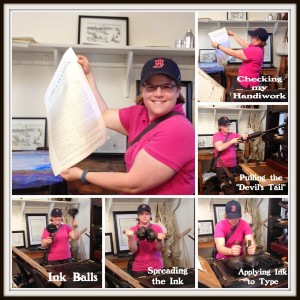 Have you ever operated an 18th-century printing press?
On June 30, 2014, I took a couple of friends around Boston’s Freedom Trail. We stopped in the Printing Office of Edes & Gill, a recreation of the printing office where Benjamin Edes and John Gill printed The Boston Gazette and Country Journal between 1755 and 1798.
Have you ever operated an 18th-century printing press?
On June 30, 2014, I took a couple of friends around Boston’s Freedom Trail. We stopped in the Printing Office of Edes & Gill, a recreation of the printing office where Benjamin Edes and John Gill printed The Boston Gazette and Country Journal between 1755 and 1798.
In this post you will learn about the colonial printing press and what it was like to print a copy of the Declaration of Independence on one.
Brief Overview of Colonial Printing
Reverend Joseph Glover brought the first printing press to English North America in 1638. After Glover died enroute to Massachusetts Bay, his widow Elizabeth Glover inherited his press and established a print shop in Cambridge, Massachusetts Bay. Glover's indentured servant Stephen Daye operated the press on her behalf.
Scholars believe The Freeman’s Oath broadside was the first tract printed in English North America.
By 1777, the 13 British North American colonies had nearly 100 master printers living in 25 towns.
How the Colonial Printing Press Worked: An Overview
Composition
 A printer uses a composition stick to place the letters of his text in the order he wishes them to appear.
A printer uses a composition stick to place the letters of his text in the order he wishes them to appear.
He places the stick in his left hand and picks up type from his cases with his right hand. As the printer has memorized the location of all the characters in his type chests, he does not look at the letters as he places them in his stick. Instead, he relies on feel and memorization to guide him through the composition stage.
The printer must compose his text upside down and backwards (right-to-left) so that it will appear right-side-up and left-to-right on the printed page.
The printer composes his text one line at a time. After he has composed his line, he sets the type in a large tray known as a galley. The galley allows the printer to view several lines of text at once and to correct any mistakes he made when composing his lines.
After the printer is satisfied with his composition, he moves his type from the galley into an iron frame known as a chase. He places wedges and fillers in this frame to tighten it up before he places the form on to his press.
Pressing
 The printer inks his type with an oil-based ink. He applies the ink evenly across his type with inking balls.
The printer inks his type with an oil-based ink. He applies the ink evenly across his type with inking balls.
After he applies the ink, the printer attaches a damp piece of paper to the tympan, or the part of the press that folds over the type. A frame called the “frisket” holds the paper in place on the tympan.
The printer folds the tympan over the type. Once folded, the printer refers to the paper-over-type combination as the “coffin.”
The printer turns a handle on the side of the press to bring the type and paper (the coffin) under the press platen or stone.
The printer pulls the bar (the Devil’s Tail) connected to the platen to apply pressure evenly across the coffin. Depending on the press and the type he has set, the printer may have to move his coffin under the platen several times. Once he is satisfied that all parts of the coffin have been pressed, he pulls it out from under the platen and removes his printed page.
Liz the Printer
On June 30, 2014, the recreated print shop of Edes & Gill had set the type of its printing press to print copies of the Declaration of Independence.
After the informative talk where I learned how printers ran their shops and used their presses, I asked to purchase one of the freshly printed copies of the Declaration.
 The interpreter must have sensed that a “history geek” stood in his presence because he asked me if I wanted to print my own copy.
The interpreter must have sensed that a “history geek” stood in his presence because he asked me if I wanted to print my own copy.
I said “yes” without any hesitation.
With the type set, I rolled the two ink balls in the oil-based ink on the inking block. The ink proved very sticky, which the printer attributed to the air conditioned room.
Once I coated the balls, I rolled them together to make sure I spread the ink over them evenly.
I took the ink balls and inked the press. As you can see from the picture, I took the job of coating all parts of the type seriously.
As I inked the type, the printer placed my damp paper on the tympan and secured it with the frisket.
I took the liberty of forming the coffin, which I then cranked under the platen.
I used the “Devils Tail” to evenly apply pressure to the coffin.
I performed the tasks of a printer perfectly until I opened the coffin and dropped my Declaration on the type. (A rookie mistake.)
Regardless, I am pleased with my slightly flawed copy of the Declaration of Independence.
Share Your Story
What experiences have you undertaken in an effort to better understand the history you study and love?
*Labeled press pictures courtesy of Common-Place Object Lessons by Jeffery D. Groves


